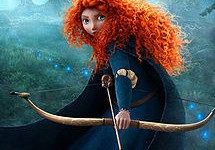 Snow White and the Huntsman is grimmest of them all. Newcomer Director Rupert Sanders strips down the cotton candy versions of ‘Snow White’ from the Disney classic to this year’s earlier Mirror Mirror, and turns his goth fantasy into a twisted spiraling opus of somber melancholy. I was intrigued by the idea and swayed by the trailers, but Sanders’ final product has me entirely convinced—he has added some serious flavor to a lacking blockbuster season.
Snow White and the Huntsman is grimmest of them all. Newcomer Director Rupert Sanders strips down the cotton candy versions of ‘Snow White’ from the Disney classic to this year’s earlier Mirror Mirror, and turns his goth fantasy into a twisted spiraling opus of somber melancholy. I was intrigued by the idea and swayed by the trailers, but Sanders’ final product has me entirely convinced—he has added some serious flavor to a lacking blockbuster season.
The story keeps things simple: the fair young princess Snow White (Kristen Stewart) is trapped in a castle tower by her evil stepmother Queen Ravenna (Charlize Theron), the supernatural woman that seduced her royal father into marriage and murdered him just before the union could be consummated. Ravenna has been cursed with immortality so long as she literally sucks the youth out of young girls. Her infamous ‘mirror on the wall’ informs her that her stepdaughter prisoner has reached an age in which she out-beautifies her and that literally consuming the heart of the princess will win her everlasting immortality. As quickly as Ravenna can send in her freakish mule of a brother to fetch Snow White from her cell, the princess makes a bold escape from the castle and treks out through the Dark Forest.
Ravenna, completely in a rage, barters with a huntsman (Chris Hemsworth) to track and retrieve Snow White in exchange for the revival of his dead wife. So the booze-smitten tracker heads off to find the princess and of course does so, but he is ultimately swayed by her purity and quest to take down the evil Queen.
At this point, if you think you know the story, you probably do. Many of the familiar plot lines converge at one point or another, until Snow White dons armor and a sword to do literal battle against Ravenna. Until then we get the seven dwarfs as you’ve never seen them before. We get the poisoned apple, love’s true kiss, and so on and so forth. But Mr. Sanders creates such a devilishly lavish spectacle that I became completely lost in the fantasy world, so gorgeous and lushly shot. I began thinking he might be a young protege of Guillermo del Toro who would most certainly be grinning throughout Sanders’ directorial debut.
 That’s not to say there aren’t a few speed bumps, such as a saggy midsection that drags and a lead performance by Kristen Stewart that shouts of too much Twilight and not enough of a departure for her. Perhaps she is completely outshined by the supporting cast—Hemsworth, the dwarfs, and especially Theron literally chew up the screen, gargle, and spit it back out. So I question whether or not any leading actress could have competed in an arena such as this where the supporting characters are so much more interesting. Stewart isn’t all bad, but she doesn’t have much to do other than squirm, stand aghast, and look somber. I half expected Edward to jump out of the bushes at any moment.
That’s not to say there aren’t a few speed bumps, such as a saggy midsection that drags and a lead performance by Kristen Stewart that shouts of too much Twilight and not enough of a departure for her. Perhaps she is completely outshined by the supporting cast—Hemsworth, the dwarfs, and especially Theron literally chew up the screen, gargle, and spit it back out. So I question whether or not any leading actress could have competed in an arena such as this where the supporting characters are so much more interesting. Stewart isn’t all bad, but she doesn’t have much to do other than squirm, stand aghast, and look somber. I half expected Edward to jump out of the bushes at any moment.
Part of Stewart’s problem may be that the film suffers mostly from the lack of a real romance between Snow White and the huntsman, because other than a dismal smooch, they don’t seem to have any romantic interest in each other. That lacking arc more than likely keeps the film from greatness because there’s no rooting passion between the two that would make their battles and sacrifices all the more impacting. I digress. I’m kicking pebbles around when Sanders’ film clearly sits atop a firm cliff of imagination and excitement. It’s because the film just barely misses greatness that I can’t seem to wonder why he went 80 percent of the way and stopped there.
As a film of tremendous atmosphere, lush visuals, startling creatures, impressive art direction, and a bloodthirsty performance from Theron—Snow White and the Huntsman is among the fairest summer tentpoles and deserves to be seen on the big screen.
[Rating:4/5]




















